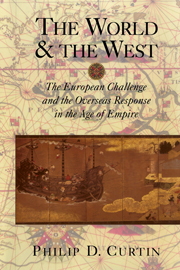Book contents
- Frontmatter
- Contents
- Preface
- Part One Conquest
- Part Two Culture Change and Imperial Rule
- Part Three Conversion
- 7 Christian Missions in East Africa
- 8 Varieties of Defensive Modernization
- 9 Meiji Japan: Revolutionary Modernization
- 10 Ottoman Reactions to the West
- Part Four Independence and the Liquidation of Empires
- Index
8 - Varieties of Defensive Modernization
Published online by Cambridge University Press: 05 June 2012
- Frontmatter
- Contents
- Preface
- Part One Conquest
- Part Two Culture Change and Imperial Rule
- Part Three Conversion
- 7 Christian Missions in East Africa
- 8 Varieties of Defensive Modernization
- 9 Meiji Japan: Revolutionary Modernization
- 10 Ottoman Reactions to the West
- Part Four Independence and the Liquidation of Empires
- Index
Summary
The four essays that make up this section deal broadly with cultural conversion on the initiative of the borrowers. Even when Christian missionaries took the initiative, the decisions of local people were decisive, as in the case of the Ganda. Other Christian missions with a similar programs met very different conditions overseas and had a radically different measure of success. The Western threat, however, was most clearly identified as political and military, and non-Westerners most often responded by borrowing what they could of military and organizational technology. This chapter deals with a number of instances of defensive modernization, and it will also serve as a background for the more detailed consideration of modernization in Japan and Turkey in the two chapters than follow.
It is important, however, to go further back in time to earlier and fundamental patterns of world history that are broader than those involving the West and the rest of the world, and to begin near the beginning with the diffusion of agriculture, which not only marks the commencement of one of the principal eras in world history; but also raises important questions about the role of diffusion and independent invention in historical change.
The Diffusion of Agriculture
An old debate involves the relative importance of diffusion of knowledge as against independent invention. Both the Maya and the ancient Egyptians, for example, built pyramids. Did the Maya somehow or other learn from the Egyptians?
- Type
- Chapter
- Information
- The World and the WestThe European Challenge and the Overseas Response in the Age of Empire, pp. 128 - 155Publisher: Cambridge University PressPrint publication year: 2000



